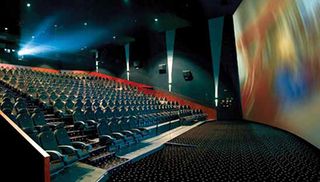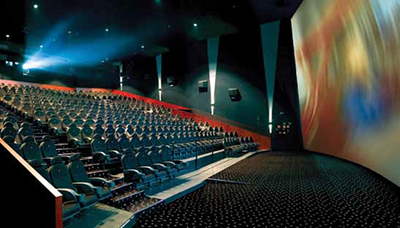AV Technology editors: How has the transition to digital projection affected the industry in the past few years? Who are the winners and losers of the move away from traditional film?
Brian Bonnick, IMAX CTO
Brian Bonnick: The adoption of digital technology has provided several benefits to the entire industry— affecting everyone from the studios, exhibitors, to moviegoers.

From a technical and visual perspective, digital projection provides a smoother presentation—it never flickers and doesn’t degrade in quality after multiple uses. Digital projectors don’t suffer the weave and jitter or image degradation compared to film (which can fade due to the projector lamp). Unlike film, digital prints will also never scratch, tear, or degrade.
Digital projection is also more cost effective for exhibitors and studios—drastically reducing the cost of film prints and allowing for more programming flexibility. For IMAX, it has allowed us to expand our theater network to more than 52 countries, and bring even more IMAX movies to audiences across the globe.
In addition to the advantages the format has brought to capture and workflow, digital projection has also allowed filmmakers to utilize new projection techniques such as high-frame rate 3D like Peter Jackson did in The Hobbit: An Unexpected Journey.
Major transitions in technology in the past certainly didn’t occur overnight— and the same applies for the cinema industry’s shift to digital projection. At IMAX, we’re not just transitioning to digital; we’re creating from the ground up the next-generation of digital cameras, projection and sound systems and image enhancement software.
We’re currently working on developing industry-leading digital laser technology—benefiting from IMAX’s intellectual property in image quality, our partner Barco’s unique laser innovations and the digital laser intellectual property IMAX licensed from Eastman Kodak. This project represents the biggest R&D investment in the company’s history and we believe the experience will take your breath away—brighter, razor-sharp, in full lifelike colors and with robust contrast.
How do facility managers at IMAX venues guarantee totally consistent sound quality at every performance—24/7/365?

Tom Cruise’s film “Oblivion” will be specially formatted for IMAX featuring a 1.9:1 aspect ratio.In IMAX, facility managers don’t have to do anything.
Really? Why is that?
IMAX engineers are obsessed with quality. IMAX’s network operations center runs 24/7/365—monitoring every IMAX digital theater around the globe to ensure each system is always running at optimal performance. We collect and analyze thousands of data points remotely to ensure each system is always running at optimal performance. The system is so robust that if someone at the theater attempts to adjust the volume manually, IMAX’s network operations center is notified and can reset it remotely, if required.
Like most musical instruments, a sound system requires frequent tuning to achieve the desired result. IMAX uses a proprietary microphone system that is permanently installed in every IMAX theater. The system collects data from each individual channel in the speaker system and performs daily tuning calibrations. These calibrations will correct the response of the channel so the sound you hear is always perfectly tuned.
What do facility managers at IMAX venues need to know about equipment maintenance and training? Do you offer managed services or in-house troubleshooting and support?
We provide a full range of services, including internet training, installation training, remote monitoring, emergency services and 24/7 customer support (majority of calls answered within 5 seconds).
In addition to our remote monitoring capabilities on the audio side, we have also built-in quality assurance measures to in our projection system. IMAX projectors are equipped with a proprietary image enhancer—a super computer with the power of 100 desktop computers. This device features a built-in remote sensor that actually monitors the screen as if it were the audience’s eyes and makes real-time adjustments to ensure the system is always delivering the best image quality.
What are the notable cinema audio and video trends in 2013 that we should watch as AV and IT managers?
I believe that both laser and 4K will be game-changers, but neither is ready—in any format—today. While strides are being made in the manufacturing of 4K equipment, studios, though excited by 4K technology, have not made the full transition to capturing and managing post-production in 4K—leaving the 4K projectors that exist today with little 4K content to show. The benchmark solution we’re working on will solve the major limitations of current 4K projection technology by providing an extremely bright and sharp image not currently attainable, as well as blacker blacks and a wider color gamut.
From an IMAX perspective, we’ve seen more and more filmmakers looking to differentiate their films, by either filming with our extremely high-resolution cameras to deliver unprecedented quality, or specially formatting their films— using a larger aspect ratio—to provide a more immersive experience. In fact, 2013 will mark the first year two major blockbusters will feature scenes filmed in IMAX (Star Trek Into Darkness and Hunger Games: Catching Fire). Tom Cruise’s Oblivion will be specially formatted for IMAX featuring a 1.9:1 aspect ratio.
On the audio front, we’re seeing a greater focus on delivering more accurate sound by mapping objects to specific speakers, so that you can pinpoint where the sound originated in the theater, instead of the “wash of sound” created in previous surround sound systems. We’ve been focused on sound precision for quite some time at IMAX, as well as delivering a greater dynamic range, and will be taking this even further when we launch our new proprietary sound system with our laser projection system.











